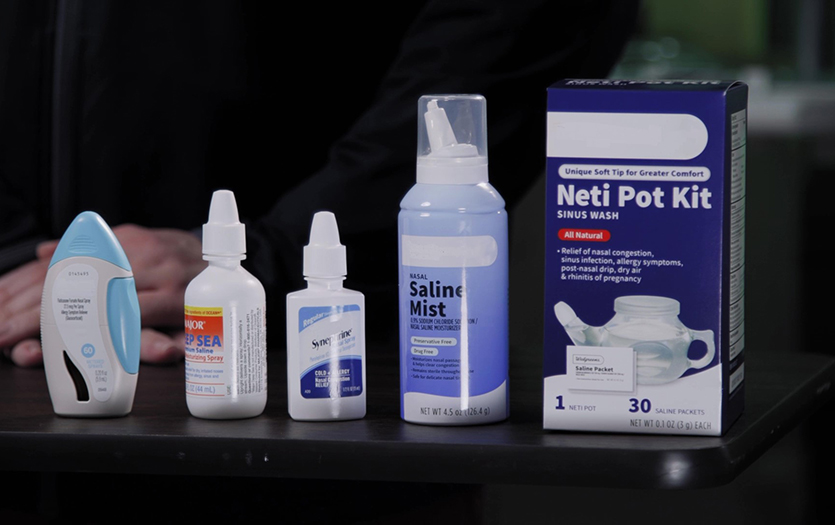When it comes to managing seasonal allergies or congestion, nasal sprays can be a lifesaver! Kevin Baumgartner, clinical pharmacist, walks us through the different types of nasal sprays, how to use them and crucial tips to ensure you get the most out of the medication.
Types of nasal sprays
Nasal sprays are available in many formulations to address specific symptoms. Below are some popular options you may find at your local pharmacy:
Decongestants - Brands like Afrin®, Xyzal®, Vicks®, and Sinex® provide temporary relief from sinus congestion and pressure, often caused by a sinus infection or other respiratory illnesses. Nasal decongestants usually contain oxymetazoline or phenylephrine as their primary active ingredients.
Corticosteroids - Products such as Flonase®, Nasacort® and Zicam® are effective for reducing nasal inflammation caused by allergies, alleviating symptoms like congestion and rhinitis. Fluticasone, budesonide and mometasone are common active ingredients in these medications.
Moisturizing sprays - Saline-based sprays and other nasal irrigation products, such as the Neti pot, offer a non-pharmacological alternative for combating nasal dryness and congestion due to excess mucus.
Learn more about additional nasal spray options here.
Administering nasal sprays
Proper nasal spray application is essential for optimal relief. While these misting devices often come in different application instruments, the most common are the push-button, squeeze-bottle and plunger. The push-button and plunger spray mechanisms may require priming before the first use or if not used recently. To do this, press the plunger or button on the device outside the nostrils until it releases a fine mist into the air.
No matter which type you choose, the administration process is the same. Follow these guidelines to use your nasal spray most effectively:
Step 1. Position the spray nozzle tip inside one of your nostrils.
Step 2. Cover the opposite nostril with one finger.
Step 3. Angle the nozzle at a slightly outward angle.
Step 4. Press the spray mechanism to release the liquid and inhale gently.
After administration, breathe in or sniff a few times to ensure the medicine remains in the nasal cavity.

Special considerations
Decongestants
Use caution when taking decongestants, as prolonged use can lead to rebound congestion. This constant nasal stuffiness returns or worsens after the medication is stopped, after stopping the medication, even without allergy or cold symptoms.
Oxymetazoline:
-
Use 2-3 sprays in each nostril up to twice daily.
-
Do not use it for more than three days to avoid rebound congestion.
-
For children over six years old, use 2-3 sprays per nostril twice daily for no more than three days.
-
If needed for more than three days or if it does not provide relief, consult a doctor.
Phenylephrine:
-
Use 2-3 sprays in each nostril every 4 hours.
-
Do not use it for more than three consecutive days to avoid rebound congestion.
-
For children aged 2-6 years, use one drop in each nostril every 2-4 hours as needed. For children six and older, use 1-3 sprays per nostril every 4 hours as needed for no more than three days.
-
If needed for more than three days or if it does not provide relief, consult a doctor.
Corticosteroids
Corticosteroids are highly effective at reducing nasal inflammation, but they require consistent use. These medications may take several weeks to reach their maximum effect. Administer these sprays as follows:
- Fluticasone: 2 sprays in each nostril once daily.
- Mometasone: 2 sprays in each nostril once daily.
- Budesonide: 2 sprays in each nostril twice daily.
- If symptoms persist after over a week of use, consult your primary care provider.
Neti pots
Nasal irrigation can help prevent dryness or congestion but consider where you source the water to avoid serious infections. Always use saline and sterilized water in your neti pot. This can be distilled or boiled tap water combined with a saline pod.
Learn more about using a neti pot for sinus congestion in this post.
Final thoughts
Nasal sprays can be an effective tool in your medicine cabinet for managing allergies and occasional congestion but require proper usage to avoid potential side effects and ensure maximum benefit. If you have additional questions on nasal spray best practices or need assistance choosing the right treatment for your symptoms, consult your primary care provider or local pharmacist.
Parkview Outpatient Pharmacies are committed to exceptional service and work directly with your doctor to ensure medication appropriateness and safety. Contact your preferred Parkview outpatient pharmacy, and our staff will gladly assist you with questions or prescription transfers.



